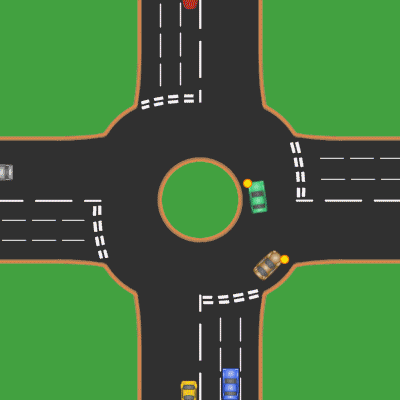|
Rond-Point
Version 2.0 Copyright ©2018 by Paul Niquette. All rights reserved.
with cars giving way and signaling, by Mintguy / Fredrik Built in 1930. the Los Alamitos Circle was first seen eighty years ago by your puzzle-master, whose father explained its technical features. He expressed admiration for the invention, which obviated traffic signals and assured safe, continuous flow of vehicles merging and diverging. "Some day," he told his son, "all intersections will be circles." That prediction has come true -- at least where your puzzle-master lives: Half of the world's roundabouts are located in France, and the name here is Rond-Point.
1. Reduced likelihood and severity of collisionsSafety (Item 1 in the list above) holds primacy: Reducing the likelihood and severity of collisions must be the principal justification for the immense investments being made by the French to replace intersections with Rond-Points. Sophisticated solvers might not be surprised to learn that 50% of all vehicle crashes worldwide occur at intersections. Here's how that estimate was reached...
 Figure 1
is a sketch of a signalized intersection with
left-turn 'pocket' lanes. Here is shown only
straight-through flow with no turns
depicted. Figure 1
is a sketch of a signalized intersection with
left-turn 'pocket' lanes. Here is shown only
straight-through flow with no turns
depicted. Only Wi-Wo and Ei-Eo are authorized to move through the intersection by green signals, while vehicles at Si and Ni are held out of the intersection by their respective red signals. There are four potential collision points, but they are 'accessible' only if a vehicle on Si-So or Ni-No violates the red signal. Crash videos showed that happening a lot!  Figure 2 is a sketch of
the same signalized intersection, this time with
all allowable turns depicted. Figure 2 is a sketch of
the same signalized intersection, this time with
all allowable turns depicted. We see two potential collision points. One is between Wi-Wo colliding with the left-turning Ei-No; the other is between Ei-Eo colliding with the left-turning Wi-So -- both authorized by green signals. The driver of a left-turning vehicle must yield right-of-way to the straight-through vehicle, which often calls for stopping in the middle of the intersection. As many as
half of the intersection crash videos showed
left-turn collisions! Merging of vehicular flows are shown at four points in Figure 2. After stopping for the red signal, the right-turning Si-Wo must yield to the straight-through Wi-Wo, then merge; likewise after stopping for the red signal, Ni-Eo must yield to the straight-through Ei-Eo, then merge. It may be appropriate to assume that the generally slower, right-turning Wi-No yields to the generally faster left-turning Ei-No and the right-turning Ei-So yields to the left-turning Wi-So. Meanwhile the driver of a left-turning vehicle Ei-No or Wi-So must grant priority first to the near head-on vehicles appearing on the right prior to the potential collision point then apparently that same driver will expect priority to be given by turning vehicles on the right at the merging point. Several intersection crash videos showed
apparent merging confusions
and resulting sideswipes! Finally, with respect to Item 8 in the list above, a conventional intersection cannot allow a U-turn or a 'retry' for a missed exit within the normal flow of traffic. Several videos show crashes caused by panicky lane changes -- often followed by sudden right or left turns at intersections.  Figure 3
depicts a Rond-Point,
which is postulated here to replace the
intersection shown in Figures 1 and 2 above. Figure 3
depicts a Rond-Point,
which is postulated here to replace the
intersection shown in Figures 1 and 2 above.One sees immediately that there are neither traffic signals nor stop signs. Moreover, there are no locations where traffic lanes actually cross one another to form potential collision points. Merging of vehicular flows are shown at four points, one for each incoming lane. Diverging of vehicular flows can be seen at the four outgoing lanes. All are utterly benign, inasmuch as neither collisions nor side-swipes can occur where vehicular flows diverge. Every vehicle entering a Rond-Point (on traffic lanes marked in orange) must yield to vehicles that are already established in the circle (on the circumferential traffic lane marked in green, which signifies 'perpetual right-of-way'). Vehicles on outgoing lanes (also marked in green) are diverging and thus cannot conflict with vehicles in the circle. Rules for drivers are elementary: On entry to a Rond-Point, always grant priority to vehicles approaching on the left. That generally calls for slowing and if necessary stopping outside the circle. A driver of a vehicle established in the circle only has to maintain safe separation from the vehicle ahead and watch for the appropriate exit. With respect to Item 8 in the list above, a driver can stay in the circle as necessary to re-access a missed exit or to make a U-turn.
 Compared
to a
typical
intersection, therefore, the Rond-Point clearly
offers advantages in
traffic safety as described
above. What about traffic performance? Compared
to a
typical
intersection, therefore, the Rond-Point clearly
offers advantages in
traffic safety as described
above. What about traffic performance?
In the the list above of Rond-Point advantages, Item 3 seems quite promising... Giving way on entry generally obviates the need for full stops....inasmuch as every traffic stop decreases vehicular speed. Here, then, is our question...
|

